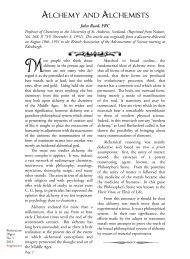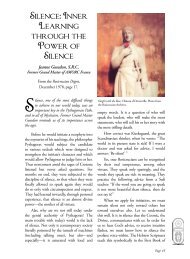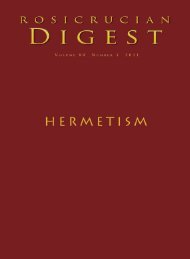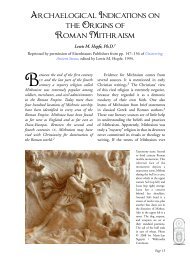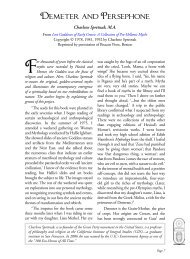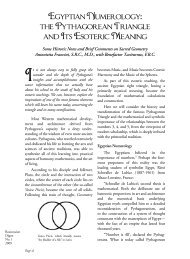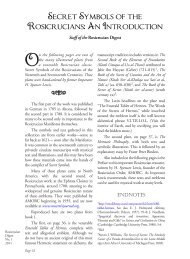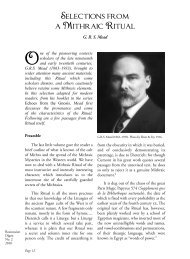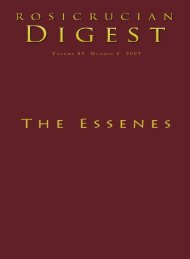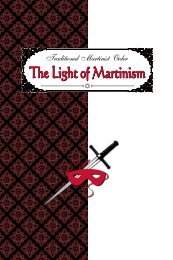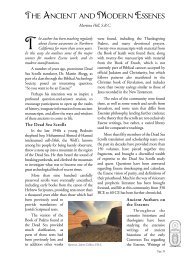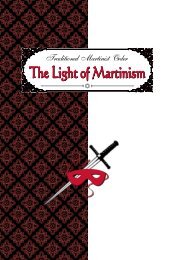Digest - Rosicrucian Order
Digest - Rosicrucian Order
Digest - Rosicrucian Order
Create successful ePaper yourself
Turn your PDF publications into a flip-book with our unique Google optimized e-Paper software.
<strong>Rosicrucian</strong><br />
<strong>Digest</strong><br />
No. 1<br />
2007<br />
regarding the creation of the world and the<br />
origin of souls. These texts, generally<br />
attributed to Hermes Trismegistus, claim to<br />
be translated from the Egyptian. In truth,<br />
they contain few authentic Egyptian elements.<br />
They are essentially characterized by Greek<br />
philosophy, but also by Judaism and<br />
Zoroastrianism. They do not compose a<br />
coherent whole and present numerous<br />
doctrinal contradictions.<br />
Pax Romana<br />
Among the Greeks the influence of Egypt<br />
was felt primarily through its literature, but<br />
among the Romans the influence took a<br />
different twist. The latter were not content to<br />
travel to the land of the pharaohs. In 30 BCE,<br />
after the suicide of Cleopatra and the conquest<br />
of Egypt by Octavian, the country became a<br />
Roman province. At the beginning of the first<br />
century CE the Romans controlled the Nile<br />
valley. They embraced its culture, and the<br />
emperor was compared to a pharaoh. The<br />
conquerors adopted certain rites of the land<br />
they had taken, and the cult of Isis found a<br />
home in Rome.<br />
Rome adopted Egyptian architecture.<br />
Even now we can admire one of the last<br />
remnants of this era, the pyramid of Caius<br />
Cestius. Another, now vanished, was erected<br />
in the necropolis of the Vatican. The city also<br />
bristled with numerous obelisks taken from<br />
Karnak, Heliopolis, and Sais. Visitors to<br />
Rome may still admire more than ten of<br />
them. The existence of an Isiac college is<br />
attested around 80 BCE. By 105 BCE a<br />
temple consecrated to the worship of Isis was<br />
located in Pompeii. The Iseum in the Campus<br />
Martius, which included a temple dedicated<br />
to Isis and Serapis, remained the most<br />
important evidence of the presence of<br />
Egyptian cults among the Romans.<br />
But the encounter of the two religions did<br />
not pass smoothly, and Caesar barely favored<br />
the gods of Egypt. Virgil (70–19 BCE) and<br />
Horace (65–8 BCE) described the battle of<br />
monstrous divinities, as Anubis brandished his<br />
arms against Neptune, Venus, and Minerva.<br />
Page 6<br />
Ovid (43–17/18 BCE) saw things in a more<br />
flattering light. The cult of Isis was tolerated in<br />
Rome, and Nero (37–66 CE) introduced<br />
some Isiac feast days in the Roman calendar.<br />
Marcus Aurelius (161–180 CE) constructed a<br />
temple for the Egyptian Hermes.<br />
In the second century CE the Pax<br />
Romana established peace throughout the<br />
Mediterranean world. In this era, we find a<br />
veritable passion for past civilizations: the<br />
Hindus, Persians, Chaldeans, and above all<br />
the Egyptians. Fascinated by Egyptian<br />
temples that were still in operation, rich<br />
Romans flocked to the land of the pharaohs.<br />
Apuleius, a Latin writer intrigued by the<br />
mysteries, also went there. In The Golden Ass<br />
he described for us the Egyptian mysteries in<br />
his colorful manner.<br />
Alchemy, Magic, and Astrology<br />
Along with alchemy, magic and astrology<br />
assumed greater importance. Claudius Ptolemy<br />
(ca. 90–ca.168 CE), a Greek living in<br />
Alexandria, wrote the Tetrabiblos, a treatise that<br />
codified all the principles of Greek astrology<br />
(with Egyptian and Chaldean influences):<br />
signs, houses, aspects, elements. Ptolemy was<br />
not merely an astrologer, he was also an<br />
astronomer to whom we owe geocentrism and<br />
the theory of the epicycles which dominated<br />
science until the seventeenth century CE. It<br />
was Ptolemy who transmitted Greek<br />
astronomical knowledge to the West. Clement<br />
of Alexandria (ca. 150–ca. 213 CE), a Greek<br />
church father, drew in his Stromateis a portrait<br />
of the Egyptian astrologers of his time who<br />
always had to be ready to recite the four<br />
astrological books of Hermes.<br />
Olympiodorus (fifth or sixth century CE)<br />
presented alchemy as a sacerdotal art practiced<br />
by the Egyptians. The Leiden and Stockholm<br />
papyri (second century CE) depict the<br />
metallurgical procedures as effectively being<br />
linked to magical formulas. 5 In the third<br />
century CE, Zosimos of Panopolis settled<br />
down in Alexandria so as to dedicate himself<br />
to alchemy. The first well-known alchemical<br />
author, he bestowed upon this science his




